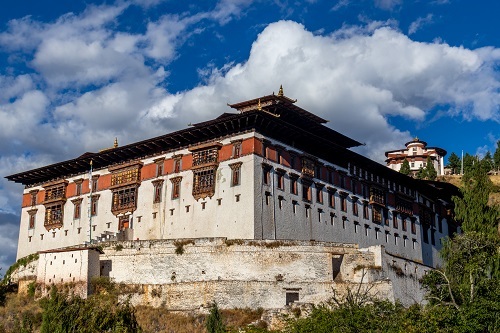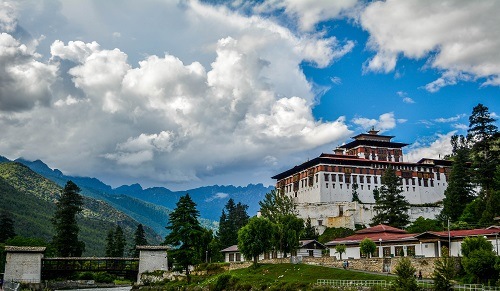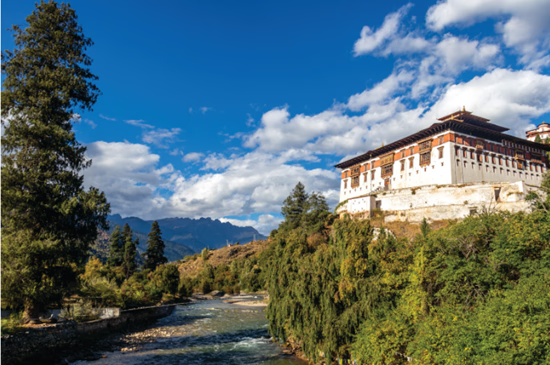
Paro Dzong, also known as Rinpung Dzong, stands as one of Bhutan’s most iconic landmarks, blending centuries of history with breathtaking architecture. Perched above the Paro Valley, this fortress has long served as both a religious and administrative hub, attracting visitors from around the world.
Whether you’re drawn to its cultural significance, the vibrant festivals like Paro Tsechu, or the stunning views it offers, visiting Paro Dzong is a must on any Bhutan travel itinerary.
Read on to discover its rich history, essential travel tips, and nearby attractions that will enhance your journey.
History Of Paro Dzong
Paro Dzong, a 17th-century fortress, is deeply significant as a symbol of Bhutan's defense and spiritual unity. Its architecture and legacy continue to reflect the region's rich cultural heritage.
Founding And Construction
Paro Dzong, officially called Rinpung Dzong, was constructed in 1646 under the guidance of Zhabdrung Ngawang Namgyel, the unifier of Bhutan. It was strategically built on a hill overlooking the Paro Valley to serve as both a fortress and a monastery. The site was chosen for its defensive advantages, protecting the region from Tibetan invasions.
Historical Significance
Beyond its role in military defense, Paro Dzong has long been a central figure in the Bhutanese administration and religion. The Dzong has housed the district's government offices and monastic quarters, representing the delicate balance between Bhutan's civil and spiritual leadership. It played a crucial role in safeguarding the country's sovereignty during conflict and is a living symbol of Bhutan's rich heritage.
Architectural Highlights
Paro Dzong is a masterpiece of traditional Bhutanese architecture, showcasing the country’s unique building techniques. The fortress is adorned with intricate wood carvings, bright murals, and exquisite paintings that narrate Buddhist legends. Its five-story central tower (Utse) stands tall, offering a glimpse into Bhutan's ancient architectural prowess. The combination of functionality and beauty makes the Dzong a marvel for visitors.
Festivals You Can Attend At Paro Dzong
Paro Dzong hosts the vibrant Paro Tsechu festival, a major religious and cultural celebration in Bhutan, featuring traditional mask dances and spiritual ceremonies that attract visitors from all over.
Paro Tsechu
One of Bhutan’s most vibrant and significant festivals, Paro Tsechu, occurs annually at Paro Dzong. This festival celebrated in honor of Guru Rinpoche, is a spiritual and social event that draws locals and visitors alike.
It features mesmerizing mask dances performed by monks in elaborate costumes, representing Buddhist teachings and legends. The atmosphere is filled with devotion, joy, and color, as people gather to receive blessings and celebrate their faith.
Tips For Attending
If you plan to attend the Paro Tsechu, the best time to visit is spring, typically around March or April. The festival lasts five days, with the final day being the most spectacular, featuring the unveiling of the giant thangka, or "thondrol."
Visitors should arrive early to secure a good viewing spot and dress respectfully, covering shoulders and legs. Participating in the festival is an incredible opportunity to immerse yourself in Bhutanese culture and spirituality.

Nearby Attractions You Can Visit
Paro Dzong is surrounded by several other cultural and natural landmarks that enrich your visit to the Paro Valley. Here are some must-see attractions nearby.
National Museum Of Bhutan
Located just above Paro Dzong, the National Museum is housed in a former watchtower, Ta Dzong. The museum showcases a vast collection of Bhutanese artifacts, from ancient weapons and religious thangkas to masks used in traditional dances. Visitors can also learn about Bhutan’s wildlife, historical figures, and cultural heritage. The museum offers breathtaking views of Paro Valley, making it a perfect complement to your visit to the Dzong.
Tiger’s Nest Monastery (Taktsang Monastery)
Just a short drive from Paro Dzong lies one of Bhutan’s most famous landmarks, Tiger’s Nest Monastery. Perched on the edge of a cliff, this monastery is a spiritual icon and offers visitors a scenic and challenging hike. Legend has it that Guru Rinpoche meditated here, making it one of the most sacred sites in Bhutan. The hike takes around three hours each way and offers stunning views of the monastery and the surrounding valleys.
Chele La Pass
A trip to Chele La Pass is highly recommended for nature lovers and photographers. At an elevation of nearly 4,000 meters, it is the highest motorable pass in the country, offering panoramic views of the Paro Valley and the Himalayan range. The drive to the pass is filled with scenic landscapes, forests, and fluttering prayer flags. This is a perfect spot for a day trip and offers incredible photo opportunities.
What To Expect During Your Visit

Visiting Paro Dzong offers more than just a glimpse into Bhutan's history. The fortress is an immersive experience that blends cultural, religious, and scenic elements, leaving a lasting impression on travelers.
Visitor Experience
Paro Dzong is considered one of the finest examples of Bhutanese architecture and one of the top tourist attractions in Bhutan. You can see this impressive dzong as you land at Paro Airport. Rinpung Dzong is easily accessible, only a 15-minute walk from Paro town.
As you enter Paro Dzong, you’ll be greeted by a sprawling courtyard surrounded by impressive structures that serve administrative and monastic purposes. The intricate wood carvings, towering walls, and ancient murals bring Bhutanese heritage to life.
Don’t miss the opportunity to visit the temples within the Dzong, where you can admire statues of deities and observe monks in prayer. The peaceful atmosphere and historical depth make it a profound cultural experience.
Practical Tips
The Dzong is open to visitors daily from 9 AM to 5 PM. Entry is free, but remember to bring your entry permit or visa, as it will be checked at the gate. Additionally, respectful attire is essential, as the Dzong remains a working religious site. Cameras are permitted in the courtyards, but photography inside the temples is typically restricted.
Conclusion About Paro Dzong
Paro Dzong is a remarkable symbol of Bhutan’s rich history, spirituality, and architectural beauty. From its captivating festivals to serene courtyards, this fortress connects deeply to Bhutanese culture.
Exploring Paro Dzong and its nearby attractions provides travelers with an unforgettable experience. To ensure you make the most of your visit, trust DrukAsia, Bhutan’s top tour agency, for a seamless and enriching journey.
Book with DrukAsia today and discover the magic of Bhutan firsthand.
Check out the Paro Tshechu Festival itinerary.
Frequently Asked Questions About About Paro Dzong
What Is The Significance Of Paro Dzong In Bhutanese History?
Paro Dzong is a key historical site in Bhutan. It served as both a religious center and a fortress that protected the region from invasions. It remains a symbol of Bhutan’s rich cultural and spiritual heritage.
When Is The Best Time To Visit Paro Dzong?
The best time to visit Paro Dzong is spring (March to May) and autumn (September to November), when the weather is mild and the surrounding landscape is stunning.
What Festivals Are Held At Paro Dzong?
The most notable festival is the Paro Tsechu, a religious celebration with masked dances and rituals. It usually occurs in March or April and is a significant cultural event in Bhutan.
Can I Take Photos Inside Paro Dzong?
Photography is allowed in the courtyards of Paro Dzong, but it is generally restricted inside the temples to respect the site's sacred nature.